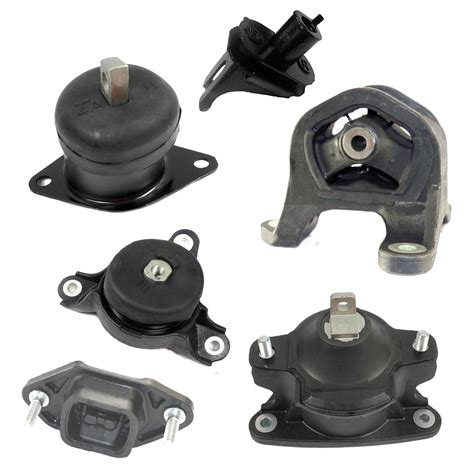Explore the significance, signs of wear, and replacement of engine and transmission mounts, plus the benefits of upgrading for enhanced vehicle performance.When it comes to vehicle performance and safety, engine and transmission mounts play a crucial role that often goes unnoticed. These small yet vital components are designed to secure the engine and transmission to the vehicle’s chassis, providing stability and reducing vibrations. Understanding what engine and transmission mounts are and their importance can help you maintain your vehicle effectively. In this blog post, we’ll explore the function of these mounts, the signs that indicate they may need replacement, and how to replace them yourself if necessary. Additionally, we’ll discuss the benefits of upgrading to high-performance mounts, helping you make informed decisions about your vehicle’s longevity and performance. Whether you’re a seasoned mechanic or just starting to learn about car maintenance, this guide will provide valuable insights into the world of engine and transmission mounts.
What are engine and transmission mounts?
Engine and transmission mounts are critical components in the vehicle’s structure, serving as the connection points between the engine, transmission, and the car’s chassis, thereby effectively absorbing vibrations and reducing noise generated during operation. These mounts are typically made of a combination of rubber and metal, which provides a resilient platform that can flex and absorb some of the engine’s moving forces while still maintaining the structural integrity necessary to keep the engine and transmission secured in place. Their primary purpose is to isolate the engine and transmission from the rest of the vehicle, minimizing the amount of vibration and shock that may affect other components or the cabin space.
In the case of engine mounts, they often have to withstand significant loads and stresses as well as thermal expansion due to the heat generated by the engine, which is why they must be constructed from durable materials that can withstand various environmental factors, ensuring that they last as long as the vehicle itself. Transmission mounts, on the other hand, are specifically designed to support the transmission assembly and maintain its alignment with the driveshaft, ensuring a smooth transfer of power from the engine to the wheels, which is critical for the overall performance of the vehicle.
Without properly functioning engine and transmission mounts, a vehicle can experience a host of issues, including increased noise and vibration, distorted suspension geometry, and unduly strain on the drivetrain components, which can lead to more significant mechanical failures over time. Therefore, understanding what these mounts are and their function is vital for every vehicle owner, enabling them to recognize potential issues early and maintain their vehicle’s performance and comfort.
The importance of engine and transmission mounts
The role of engine and transmission mounts in any vehicle is crucial as they serve as the vital connection between the engine, the transmission, and the vehicle’s chassis; without these mounts, the engine and transmission would not only have difficulty properly aligning but would also transmit excessive vibrations and noises to the vehicle’s interior, creating an uncomfortable ride for the occupants as well as potentially leading to catastrophic failure over time.
Moreover, these mounts are not merely functional, but their importance extends beyond performance to safety, because they help to absorb excess noise and vibrations, thereby protecting the driver and passengers from an unpleasant driving experience, and additionally, they play a pivotal role in maintaining the overall stability of the engine and gearbox, which can significantly impact the handling characteristics of the vehicle.
In conclusion, considering the impact of worn-out or damaged engine and transmission mounts cannot be understated, as compromised mounts may lead to misalignment issues that can result in increased wear on various components of the drivetrain, diminished fuel efficiency, and even higher costs due to necessary repairs or replacements; hence, regular inspection and timely replacement of these mounts when needed can not only prolong the life of the vehicle’s e
Signs of worn-out engine and transmission mounts
The engine and transmission mounts play a crucial role in supporting vital components of a vehicle while absorbing the effects of vibrations, and when these mounts begin to wear out, it can lead to a variety of noticeable signs that can significantly affect the performance and safety of your vehicle.
One of the most common indicators of worn-out engine and transmission mounts is an increase in vibration felt in the cabin, which can occur when the mounts lose their ability to dampen engine vibrations effectively, leading to a rough ride that becomes more pronounced at higher speeds, ultimately making the driving experience less comfortable.
Additional warning signs include unusual engine movement, which can be observed during acceleration or deceleration; for example, if you notice the engine tilting or shifting noticeably in its compartment or if you hear clunking or banging noises during gear changes, it is imperative to inspect your mounts as these symptoms may signal that they have degraded and require immediate attention to avoid further damage.
How to replace engine and transmission mounts
Replacing engine and transmission mounts is a task that, while it may seem daunting to some, is achievable with the right tools and a little mechanical know-how, as these mounts are crucial for stabilizing your engine and transmission, reducing vibrations, and ensuring an overall smooth driving experience.
To begin the process of replacement, it is essential to gather the necessary tools which include a socket set, wrenches, a jack, jack stands, and potentially a torque wrench, as these tools will enable you to access the mounts effectively and securely detach and reattach them without compromising their integrity.
Once you have gathered your tools, the first step is to ensure that you park your vehicle on a flat surface, then engage the parking brake, and use a jack to lift the vehicle safely; make sure to place jack stands under the vehicle to provide added security before you begin loosening the bolts connecting the mounts to the frame, remembering to consult your vehicle’s service manual for specific instructions related to the exact types of engine and transmission mounts, which can v
The impact of upgraded engine and transmission mounts
Upgrading engine and transmission mounts can significantly enhance a vehicle’s performance by providing greater stability, improved handling, and reduced vibrations, all of which contribute to a more enjoyable driving experience. When you invest in higher-quality mounts, you not only ensure better alignment of the engine and transmission with the vehicle’s chassis, but you also decrease the likelihood of mechanical failures that could result from excessive movement caused by worn or inadequate mounts. This enhanced durability and resilience prevent misaligned or vibrating components from compromising the overall functionality of crucial systems, such as the drivetrain and suspension.
Furthermore, the benefits of upgraded engine and transmission mounts extend to the vehicle’s responsiveness and driving dynamics, leading to smoother acceleration and deceleration. By choosing performance mounts, drivers often note an increase in steering precision, which is particularly beneficial during aggressive maneuvers or while navigating challenging terrains, as these mounts offer superior support compared to stock options. The materials used in these upgrades, such as high-density rubber, polyurethane, or even solid aluminum, provide heightened performance attributes, ensuring that the engine and transmission maintain their position under extreme conditions, thus fostering confidence and control for the driver.
In addition to improving performance and handling, upgrading engine and transmission mounts can also contribute to extended lifespan of the vehicle itself. Given that worn or weak mounts can lead to stress on engine-related components, such as exhaust systems or wiring harnesses, maintaining a strong foundation for these parts helps prevent premature wear and tear. Ultimately, the decision to upgrade mounts is not merely about enhancing performance; it is also a strategic approach to maintaining a vehicle’s integrity and value over time, ensuring that every drive is as smooth and stable as possible.
Frequently Asked Questions
What are engine and transmission mounts?
Engine and transmission mounts are components that secure the engine and transmission to the vehicle’s chassis, helping to stabilize them and reduce vibrations.
Why are engine and transmission mounts important?
They are crucial for maintaining the alignment of the engine and transmission, ensuring that they function properly and enhancing overall vehicle performance.
What are the common signs of failing mounts?
Common signs include excessive vibrations, unusual noises from the engine compartment, and misalignment issues, which may cause difficulty in shifting gears.
How often should engine and transmission mounts be inspected?
It’s advisable to inspect them during regular maintenance checks or if you notice symptoms of wear or damage, generally every 30,000 to 60,000 miles.
Can I replace engine and transmission mounts myself?
If you have mechanical experience and the right tools, you can replace them yourself; however, it’s often recommended to seek professional assistance due to the complexity of the task.
What materials are commonly used for engine and transmission mounts?
Most mounts are made from rubber or polyurethane, which provide flexibility and durability to absorb vibrations effectively.
How do I choose the right mounts for my vehicle?
Choose mounts that are specifically designed for your vehicle’s make and model to ensure proper fit and functionality; quality brands and materials should also be considered for longevity.





